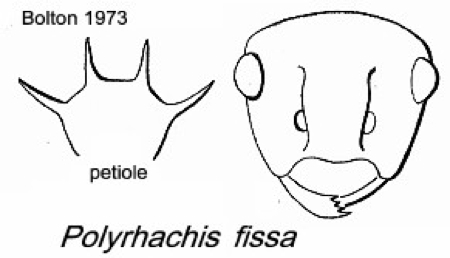Polyrhachis fissa Mayr
  Type location Cameroun (Polyrhachis fissus nov. spec.,
Mayr,
1902: 301, worker & queen), collected at Victoria by Buchholz - see below Type location Cameroun (Polyrhachis fissus nov. spec.,
Mayr,
1902: 301, worker & queen), collected at Victoria by Buchholz - see below
junior synonym (part synonymy by Bolton, 1973b: 304)
ugandensis
(Polyrhachis (Myrma) fissa ugandensis
subsp. n., Arnold, 1954: illustrated, worker) from Uganda,
Entebbe, G Arnold - no images on Antweb (December 2014)
(see Bolton,
1995)  . .
|
 WORKER - TL 5.2-6.3 m; distinguished by the deeply
incised and distinct transverse striations on the propodeum. Colour
black, the gaster distinctly shiny, antennal funiculi usually lighter
brown, legs vary often lighter (Bolton, 1973b: 304, illustrated,
full-face view, anterior petiole). WORKER - TL 5.2-6.3 m; distinguished by the deeply
incised and distinct transverse striations on the propodeum. Colour
black, the gaster distinctly shiny, antennal funiculi usually lighter
brown, legs vary often lighter (Bolton, 1973b: 304, illustrated,
full-face view, anterior petiole).
Wheeler (1922) listed other findings from Cameroun (at
Bibundi by Tessmann, at Mundame by Conradt) and Rio Muni. He described bequaerti
as a new species, with an illustration, noting that the nest consisted
of two leaves united by a soft tissue comprised of fibrous, gnawed
vegetable particles and silk (Bolton examined the type and Wheeler's
specimens and found no differences).
Bernard (1952, not referenced by Bolton, 1973b)
described it as a rare form, from Spanish Guinea and Cameroun. Two
alate females were collected in Guinea, at Nion and Yalanzou; 4
workers at Camp IV (1000 m).
Found in Ghana cocoa. Reported by Strickland
(1951a), as P. fissus, an arboreal species making small
circular carton nests on the underside of leaves, which is common in
relatively restricted areas but rare elsewhere. Found later at Kade by
Majer (1975, 1976b), using pkd, with 1-2 workers per sample; and on
cocoa mistletoe (Room, 1975). Bolton (1973b) lists it from three of the
cocoa canopy survey sites (Nswam, Aburi and Asamankese) of Room (1971,
which has one collection only), plus CRIG (B. Bolton; C.A.
Collingwood) and Korangang (J. Paine). Four workers were collected,
three by canopy pkd and one on the ground from a block of mature
Amelonado cocoa at CRIG by Bigger (1981a).
Bolton (1973b) also lists findings from Cameroun,
no location (G. Mayr) and Equatorial Guinea. He cites it as arboreal
and making nests of vegetable particles and silk.
Note (April 2015): The type images suggest that Polyrhachis bequaerti
merits raising to separate species status. Fresh workers from
Ivory Coast are identical to the Wheeler type and I have given it revived status. Bolton's (1973b) note of fissa as being distinguished by "deeply incised and distinct striations on the propodeum" applies to bequaerti and the type fissa has only weakly sculpturation on the propodeum or on the pronotum. P. fissa also has quite abundant erect hairs over the whole alitrunk dorsum and sparse but obvious erect hairs on the gaster dorsum. P. bequaerti
has few, very fine, erect hairs on the pronotum dorsum and almost none
on the gaster. The small notch adjacent to the outer insertion of
the antennae that Bolton described as separating lauta from P. fissa is small but readily seen in P. bequaerti.
The comments and findings on fissa therefore require to be considered as ambiguous.
|